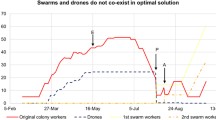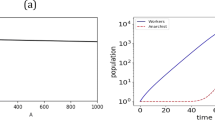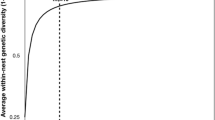Abstract
Queens of the honey bee, Apis mellifera (L.), exhibit extreme polyandry, mating with up to 45 different males (drones). This increases the genetic diversity of their colonies, and consequently their fitness. After copulation, drones leave a mating sign in the genital opening of the queen which has been shown to promote additional mating of the queen. On one hand, this signing behavior is beneficial for the drone because it increases the genetic diversity of the resulting colony that is to perpetuate his genes. On the other hand, it decreases the proportion of the drone’s personal offspring among colony members which is reducing drone fitness. We analyze the adaptiveness and evolutionary stability of this drone’s behavior with a game-theoretical model. We find that theoretically both the strategy of leaving a mating sign and the strategy of not leaving a mating sign can be evolutionary stable, depending on natural parameters. However, the signing strategy is not favored for most scenarios, including the cases that are biologically plausible in reference to empirical data. We conclude that leaving a sign is not in the interest of the drone unless it serves biological functions other than increasing subsequent queen mating chances. Nevertheless, our analysis can also explain the prevalence of such a behavior of honey bee drones by a very low evolutionary pressure for an invasion of the nonsigning strategy.
Similar content being viewed by others
References
Baer, B., & Schmid-Hempel, P. (1999). Experimental variation in polyandry affects parasite loads and fitness in a bumble-bee. Nature, 397, 151–154.
Baudry, E., Solignac, M., Garnery, L., Gries, M., Cornuet, J. M., & Koeniger, N. (1998). Relatedness among honeybees (Apis mellifera) of a drone congregation. Proc. R. Soc. Lond. B, 265, 2009–2014.
Boomsma, J. J., Fjerdingstad, E. J., & Frydenberg, J. (1999). Multiple paternity, relatedness and genetic diversity in Acromyrmex leaf-cutter ants. Proc. R. Soc. Lond. B: Biol. Sci., 266, 249–254.
Boomsma, J. J., Baer, B., & Heinze, J. (2005). The evolution of male traits in social insects. Ann. Rev. Entomol., 50, 395–420.
Estoup, A., Solignac, M., & Cornuet, J. M. (1994). Precise assessment of the number of patrilines and of genetic relatedness in honeybee colonies. Proc. R. Soc. Lond. B: Biol. Sci., 258, 1–7.
Fuchs, S., & Moritz, R. F. A. (1999). Evolution of extreme polyandry in the honeybee Apis mellifera L. Behav. Ecol. Sociobiol., 45, 269–275.
Gillespie, D. T. (1977). Exact stochastic simulation of coupled chemical reactions. J. Phys. Chem., 81(25), 2340–2360.
Gillott, C. (2003). Male accessory gland secretions: modulators of female reproductive physiology and behavior. Ann. Rev. Entomol., 48, 163–184.
Gove, R., Hayworth, M., Chhetri, M., & Rueppell, O. (2009). Division of labour and social insect colony performance in relation to task and mating number under two alternative response threshold models. Insectes Sociaux, 56, 319–331. DOI:10.1007/s00040-009-0028-y.
Hayworth, M. K., Johnson, N. G., Wilhelm, M. E., Gove, R. P., Metheny, J. M., & Rueppell, O. (2009). Added weights lead to reduced flight behavior and mating success in polyandrous honey bee queens (Apis mellifera). Ethology, 115, 698–706. DOI: 10.1111/j.1439-0310.2009.01655.x.
Koeniger, G. (1990). The role of the mating sign in honey bees, Apis mellifera L.: does it hinder or promote multiple mating? Animal Behav., 39, 444–449.
Koeniger, N., & Koeniger, G. (1991). An evolutionary approach to mating behavior and drone copulatory organs in Apis. Apidologie, 22, 581–590.
Koeniger, N., & Koeniger, G. (2007). Mating flight duration of Apis mellifera queens: as short as possible, as long as necessary. Apidologie, 38, 606–611.
Koeniger, G., Koeniger, N., & Fabritius, M. (1979). Some detailed observations of mating in the honeybee. Bee World, 60, 53–57.
Kronauer, D. J. C., Johnson, R. A., & Boomsma, J. J. (2007). The evolution of multiple mating in army ants. Evolution, 61, 413–422.
Loper, G. M., Wolf, W. W., & Taylor, O. R. (1992). Honey-Bee drone flyways and congregation areas—radar observations. J. Kans. Entomol. Soc., 65, 223–230.
Mattila, H. R., & Seeley, T. D. (2007). Genetic diversity in honey bee colonies enhances productivity and fitness. Science, 317, 362–364.
Maynard Smith, J. (1982). In Evolution and the theory of games (p. 204). Cambridge: Cambridge University Press.
Oldroyd, B. P., & Wongsiri, S. (2006). Asian honey bees: biology, conservation and human interactions. Cambridge: Harvard University Press.
Rueppell, O., Fondrk, M. K., & Page, R. E. (2006). Male maturation response to selection of the pollen-hoarding syndrome in honey bees (Apis mellifera L). Animal Behav., 71, 227–234.
Rueppell, O., Johnson, N. G., & Rychtář, J. (2008). Variance-based selection may explain general mating patterns in social insects. Biol. Lett., 4, 270–273.
Ruttner, F. (1954). Mehrfache Begattung der Bienenkönigin. Zool. Anz., 153, 99–105.
Tarpy, D. R., & Nielsen, D. I. (2002). Sampling error, effective paternity and estimating the genetic structure of honey bee colonies (Hymenoptera: Apidae). Ann. Entomol. Soc. Am., 95, 513–528.
Wattanachaiyingcharoen, W., Oldroyd, B. P., Wongsiri, S., Palmer, K., & Paar, R. (2003). A scientific note on the mating frequency of Apis dorsata. Apidologie, 34, 85–86.
Wiernasz, D. C., Perroni, C. L., & Cole, B. J. (2004). Polyandry and fitness in the western harvester ant Pogonomyrmex occidentalis. Mol. Ecol., 13, 1601–1606.
Winston, M. L. (1987). The biology of honey bees (pp. 202, 209–210). First Harvard University Press Paperback edition (1991).
Woyciechowski, M., Kabat, L., & Krol, E. (1994). The function of the mating sign in honey bees Apis mellifera L—new evidence. Animal Behav., 47, 733–735.
Woyke, J. (1964). Causes of repeated mating flights by queen honeybees. J. Apic. Res., 3, 17–23.
Woyke, J., & Ruttner, F. (1958). An anatomical study of the mating process in the honeybee. Bee World, 39, 3–18.
Author information
Authors and Affiliations
Corresponding author
Additional information
The research was supported by the NSF grant #0634182.
Rights and permissions
About this article
Cite this article
Wilhelm, M., Chhetri, M., Rychtář, J. et al. A Game Theoretical Analysis of the Mating Sign Behavior in the Honey Bee. Bull Math Biol 73, 626–638 (2011). https://doi.org/10.1007/s11538-010-9544-1
Received:
Accepted:
Published:
Issue Date:
DOI: https://doi.org/10.1007/s11538-010-9544-1




